How Sustainable Design and Awareness May Affect the Real Estate Market
Abstract
:1. Introduction
Literature Review
2. Methodology
- Understanding and awareness of greenness/sustainability
- Cost implications.
- Greenness Desirability and need
- Residential versus commercial.
Survey Results
3. Regression Analysis and Discussion
Outcomes Brief
4. Conclusions
Author Contributions
Funding
Institutional Review Board Statement
Informed Consent Statement
Data Availability Statement
Conflicts of Interest
Appendix A
Appendix A.1. Research Questionnaire
Appendix A.2. Definition of Green Building & Sustainability
Appendix A.3. Questionnaire
- Demographic questions
- What is your age?20–3030–4040–6060 or over
- 2.
- What is your gender?MaleFemale Other
- 3.
- What is your level of education?High school or LessBachelor’s Degree Master’sDegree Doctorate
- 4.
- What is your occupationArchitect and Designer EngineerEstate Agent Property Valuer Property DeveloperEnd-User (Owner, Tenant, and/or Property Potential Buyer) Owner (Potential Seller)Other
- 5.
- What is your household annual income?Below 20,000 Euro21,000–30,000 Euro31,000–40,000 Euro41,000–50,000 Euro51,000–60,000 EuroOver 60,000 Euro
- Sustainability and Greenness Research QuestionsTheme 1—Understanding and awareness of Greenness/Sustainability
- Do you understand the meaning of “Greenness” in regards to the Building Sustainability and Efficiency?Yes No
- 2.
- Do you believe that you have a clear understanding of the levels of Greenness in the Cyprus Real Estate Market?Please answer the Likert Scale question from 1 not understand to 5 understand in depth. ((1) no understanding; (2) Slight understanding; (3) Moderate understanding; (4) Understanding; (5) In depth understanding.)1 2 3 4 5
- 3.
- Are you aware of the Cyprus Government’s basic Greenness mandatory policy for Buildings?Yes No
- 4.
- To what extent do you believe that sustainability and Greenness is actually carried out in practice?Please answer the following Likert Scale question from 1 the less to 5 the most. ((1) not carried out; (2) Slightly carried out; (3) Moderate carried out; (4) Carried out; (5) Mostly carried out.)1 2 3 4 5
- 5.
- Do you believe that a property that has been following the sustainability and “Greenness” standards could be more privileged?Yes NoTheme 2—Cost Implications
- 6.
- Do you believe, according to your standards, that the sustainable or “Green” development of buildings is affordable for the general public?Yes No
- 7.
- If there were Low cost implications, should Buildings be built to the highest Greenness levels?Please answer the following Likert Scale question from 1 strongly disagree to 5 strongly agree. (1) Strongly disagree; (2) Disagree; (3) Neither agree nor disagree; (4) Agree; (5) Strongly agree.)1 2 3 4 5
- 8.
- If there were cost implications in construction (increasing the final cost of the building), would you be willing to pay for the highest possible Green Standards to Buildings?Yes No
- 9.
- Would you be willing to pay more money in order to purchase a Green and sustainable property?Please answer the following Likert Scale question from 1 not willing at all to 5 very willing. ((1) not willing; (2) Slightly willing; (3) Moderate willing; (4) Willing; (5) Very Willing.)1 2 3 4 5
- 10.
- To what extend do you desire to live and work in a “Green” and sustainable environment? Please answer the following Likert Scale question from 1 the less to 5 the most. ((1) Do not desire; (2) Slightly desire; (3) Moderate desire; (4) Desire; (5) Desire it very much.)1 2 3 4 5
- 11.
- To what extend do you need to live and work in a “Green” and sustainable environment? Please answer the following Likert Scale question from 1 the less to 5 the most. ((1) Do not need; (2) Slightly need; (3) Moderate need; (4) Need; (5) Need it very much.)1 2 3 4 5
- 12.
- Which of the following do you believe is the most important factor that influences the application of sustainability and Greenness in practice?Please choose the most appropriate factor from the following.A–Government imposition through LawB–DesireC–NeedD–Financial BenefitsTheme 4—Residential versus Commercial
- 13.
- How important do you think that Greenness is for Residential Properties?Please answer the following Likert Scale question from 1 the less to 5 the most. ((1) Not important; (2) Slightly important; (3) Moderate important; (4) Important; (5) Very important.)1 2 3 4 5
- 14.
- How important do you think that Greenness is for Commercial Properties?Please answer the following Likert Scale question from 1 the less to 5 the most. ((1) Not important; (2) Slightly important; (3) Moderate important; (4) Important; (5) Very important.)1 2 3 4 5Thank you very much for participating in this research. Your opinion is very valuable for the purposes of this research project.
References
- Garren, S.J. Sustainability definitions, historical context, and frameworks. In The Palgrave Handbook of Sustainability; Springer: Berlin/Heidelberg, Germany, 2018. [Google Scholar]
- Parris, T.M.; Kates, R.W. Characterizing and Measuring Sustainable Development. Annu. Rev. Environ. Resour. 2003, 28, 559–586. [Google Scholar] [CrossRef]
- Levine, M.Ü.-V. Climate Change 2007: Mitigation; Intergovernmental Panel on Climate Change: Geneva, Switzerland, 2007. [Google Scholar]
- Zancanella, P.B.-K. Energy Efficiency, the Value of Buildings and the Payment Default Risk; European Commission: Luxembourg, 2018. [Google Scholar]
- Enkvist, P.N. A Cost Curve for Greenhouse Gas Reduction. McKinsey Quarterly, 1 February 2007. [Google Scholar]
- Heinzle, S.L.; Yip, A.B.Y.; Xing, M.L.Y. The Influence of Green Building Certification Schemes on Real Estate Investor Behaviour: Evidence from Singapore. Urban Stud. 2013, 50, 1970–1987. [Google Scholar] [CrossRef]
- Hartenberger, U.L.; Lorenz, D.; Sayce, S.; Toth, Z. Creating an Energy Efficient Mortgage for Europe. Mortgage Lending Valuation and the Impact of Energy Efficiency: An Overview of Current Practice; RICS: London, UK, 2017. [Google Scholar]
- Doyle, T.M. Environment and Politics; Routledge: Abingdon, UK, 2015. [Google Scholar]
- Kafle, S.C. Correlation and regression analysis using SPSS. Manag. Technol. Soc. Sci. 2019, 1, 126–132. [Google Scholar]
- Fuerst, F.K. Determinants of green building adoption. Environ. Plan. B Plan. Des. 2014, 41, 551–570. [Google Scholar] [CrossRef]
- Goh, C.S.; Chong, H.-Y.; Jack, L.; Faris, A.F.M. Revisiting triple bottom line within the context of sustainable construction: A systematic review. J. Clean. Prod. 2019, 252, 119884. [Google Scholar] [CrossRef]
- Al Horr, Y.; Arif, M.; Katafygiotou, M.; Mazroei, A.; Kaushik, A.; Elsarrag, E. Impact of indoor environmental quality on occupant well-being and comfort: A review of the literature. Int. J. Sustain. Built Environ. 2016, 5, 1–11. [Google Scholar] [CrossRef]
- Assylbekov, D.; Nadeem, A.; Hossain, A.; Akhanova, G.; Khalfan, M. Factors Influencing Green Building Development in Kazakhstan. Buildings 2021, 11, 634. [Google Scholar] [CrossRef]
- JLL. 5 Ways Clean Tech Is Making Commercial Real Estate More Energy Efficient. 2022. Available online: https://www.us.jll.com/en/trends-and-insights/cities/5-ways-clean-tech-is-boosting-energy-efficiency-in-commercial-real-estate (accessed on 12 October 2023).
- O’Mara, M. Why Invest in High-Performance Green Building; Schneider Electric: North Andover, MA, USA, 2012. [Google Scholar]
- Falkenbach, H.; Lindholm, A.-L.; Schleich, H. Review Articles: Environmental Sustainability: Drivers for the Real Estate Investor. J. Real Estate Lit. 2010, 18, 201–223. [Google Scholar] [CrossRef]
- Mirror, F. Cyprus: Parliament to Summon Energy Minister over EuroAsia Debacle. Financial Mirror, 17 October 2019. [Google Scholar]
- Serghides, D.K. Indicators Toward Zero-Energy Houses for the Mediterranean Region: The Average Buildings as Means of Optimized Refurbishment Strategies for the Residential Buildings in Cyprus. In Towards Net Zero Carbon Emissions in the Buildings; Springer: Berlin/Heidelberg, Germany, 2022; pp. 235–250. [Google Scholar]
- Taliotis, C.; Giannakis, E.; Karmellos, M.; Fylaktos, N.; Zachariadis, T. Estimating the economy-wide impacts of energy policies in Cyprus. Energy Strat. Rev. 2020, 29, 100495. [Google Scholar] [CrossRef]
- Tutak, M.; Brodny, J.; Bindzár, P. Assessing the Level of Energy and Climate Sustainability in the European Union Countries in the Context of the European Green Deal Strategy and Agenda 2030. Energies 2021, 14, 1767. [Google Scholar] [CrossRef]
- Union, E. Green Deal. 2023. Available online: https://commission.europa.eu/strategy-and-policy/priorities-2019-2024/european-green-deal_en (accessed on 12 October 2023).
- Cyprus Action Plan. Cyprus’ Integrated National Energy and Climate Plan. 2020. Available online: https://energy.ec.europa.eu/system/files/2020-01/cy_final_necp_main_en_0.pdf (accessed on 10 September 2022).
- Katafygiotou, M.; Serghides, D. Analysis of structural elements and energy consumption of school building stock in Cyprus: Energy simulations and upgrade scenarios of a typical school. Energy Build. 2014, 72, 8–16. [Google Scholar] [CrossRef]
- Serghides, D.; Dimitriou, S.; Katafygiotou, M. Towards European targets by monitoring the energy profile of the Cyprus housing stock. Energy Build. 2016, 132, 130–140. [Google Scholar] [CrossRef]
- European Union. Official Website of EU. 2023. Available online: https://energy.ec.europa.eu/topics/energy-efficiency/energy-efficient-buildings/energy-performance-buildings-directive_en (accessed on 12 October 2023).
- Zhang, G.J. Facile “Spot-Heating” synthesis of carbon dots/carbon nitride for solar hydrogen evolution synchronously with contaminant decomposition. Adv. Funct. Mater. 2018, 28, 1706462. [Google Scholar] [CrossRef]
- Skordoulis, M.; Ntanos, S.; Kyriakopoulos, G.L.; Arabatzis, G.; Galatsidas, S.; Chalikias, M. Environmental Innovation, Open Innovation Dynamics and Competitive Advantage of Medium and Large-Sized Firms. J. Open Innov. Technol. Mark. Complex. 2020, 6, 195. [Google Scholar] [CrossRef]
- Khan, M.K.; Teng, J.-Z.; Khan, M.I.; Khan, M.O. Impact of globalization, economic factors and energy consumption on CO2 emissions in Pakistan. Sci. Total Environ. 2019, 688, 424–436. [Google Scholar] [CrossRef]
- Sichali, M. Awareness, attitudes and perception of green building practices and principles in the Zambian construction industry. Int. J. Constr. Eng. Manag. 2017, 6, 215–220. [Google Scholar]
- Chegut, A.; Eichholtz, P.; Kok, N. The price of innovation: An analysis of the marginal cost of green buildings. J. Environ. Econ. Manag. 2019, 98, 102248. [Google Scholar] [CrossRef]
- Nagrale, S.S. Cost comparison between normal building and green building considering its construction and maintenance phase. Int. J. Sci. Res. Eng. Dev. 2020, 3, 77–80. [Google Scholar]
- Chen, L.; Chan, A.P.; Owusu, E.K.; Darko, A.; Gao, X. Critical success factors for green building promotion: A systematic review and meta-analysis. J. Affect. Disord. 2021, 207, 108452. [Google Scholar] [CrossRef]
- Madad, A.; Gharagozlou, A.; Majedi, H.; Monavari, S. A quantitative representation of the urban green building model, focusing on local climatic factors by utilizing monetary valuation. Ecol. Econ. 2019, 161, 61–72. [Google Scholar] [CrossRef]
- Bertram, D. Likert Scales; CPSC 681—Topic Report; Department of Industrial Engineering, University of Stellenbosch: Stellenbosch, South Africa, 2007; pp. 1–10. [Google Scholar]
- PWC. Cyprus Real Estate Market Review; PWC: Nicosia, Cyprus, 2022. [Google Scholar]
- Migrants and Refugees. Country Profiles—Cyprus. 2020. Available online: https://migrants-refugees.va/country-profile/cyprus/ (accessed on 12 October 2023).
- Ye, T.; Liu, B. Uncertain hypothesis test with application to uncertain regression analysis. Fuzzy Optim. Decis. Mak. 2021, 21, 157–174. [Google Scholar] [CrossRef]
- Freund, R.J. Regression Analysis; Elsevier: Amsterdam, The Netherlands, 2006. [Google Scholar]
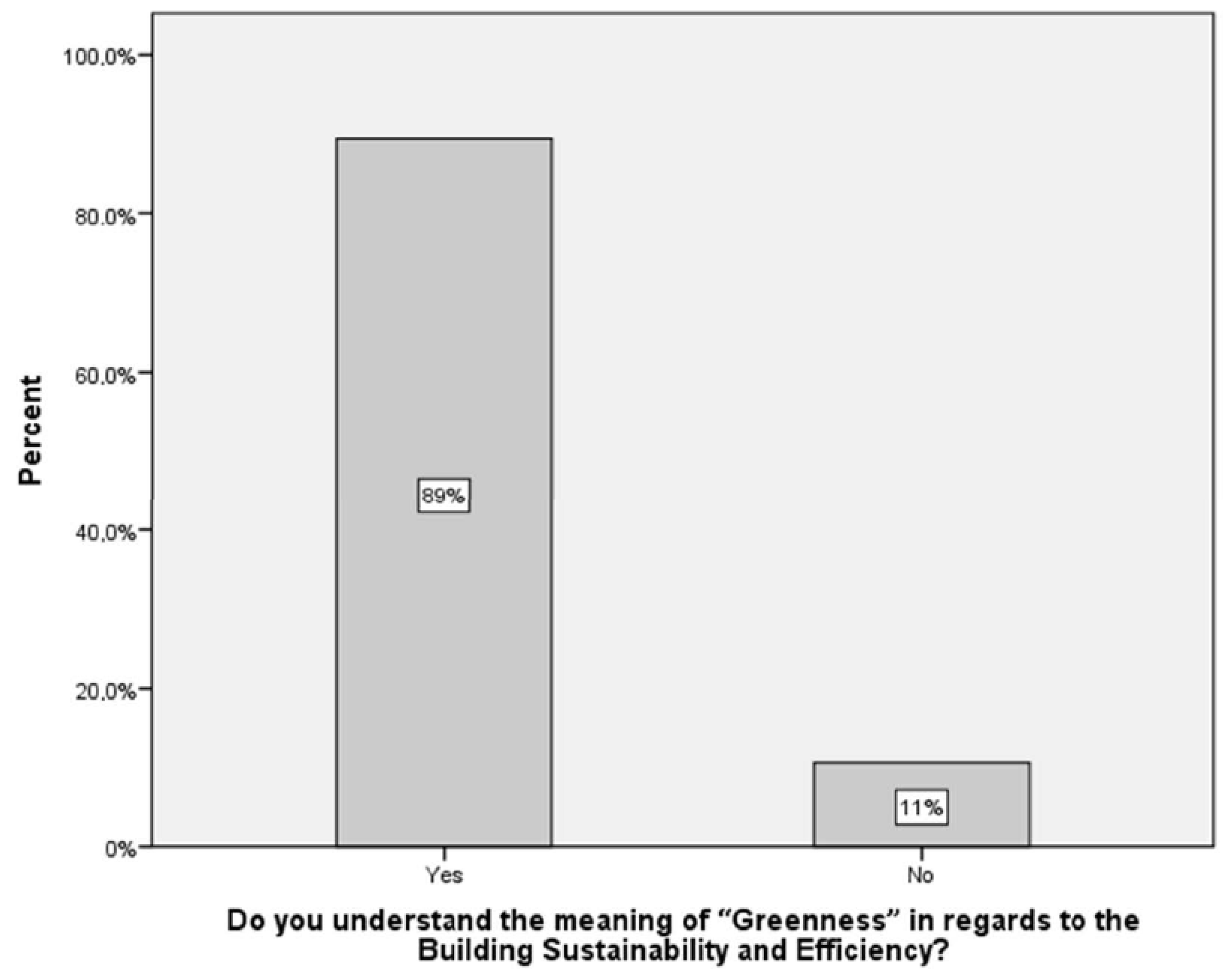
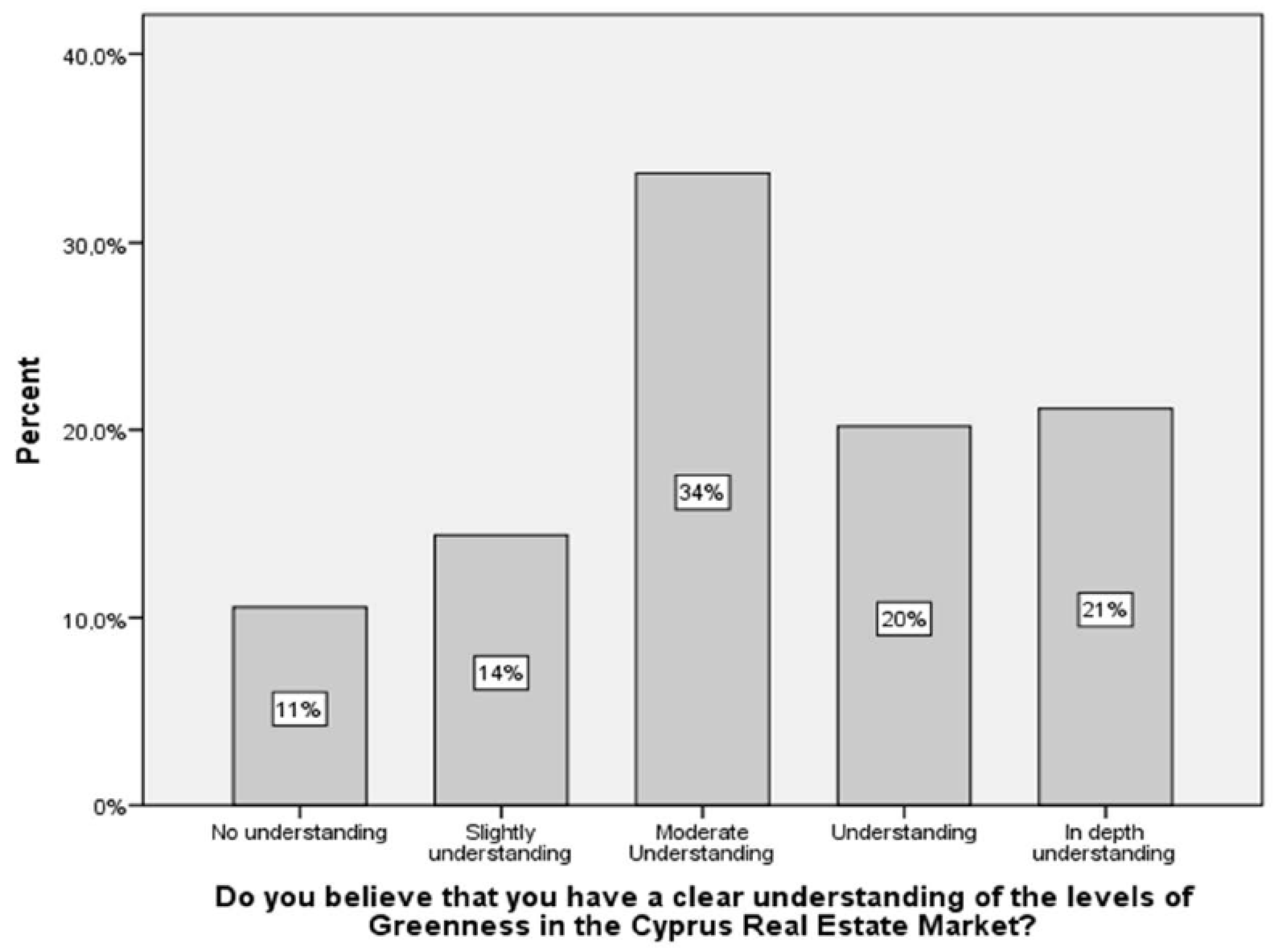
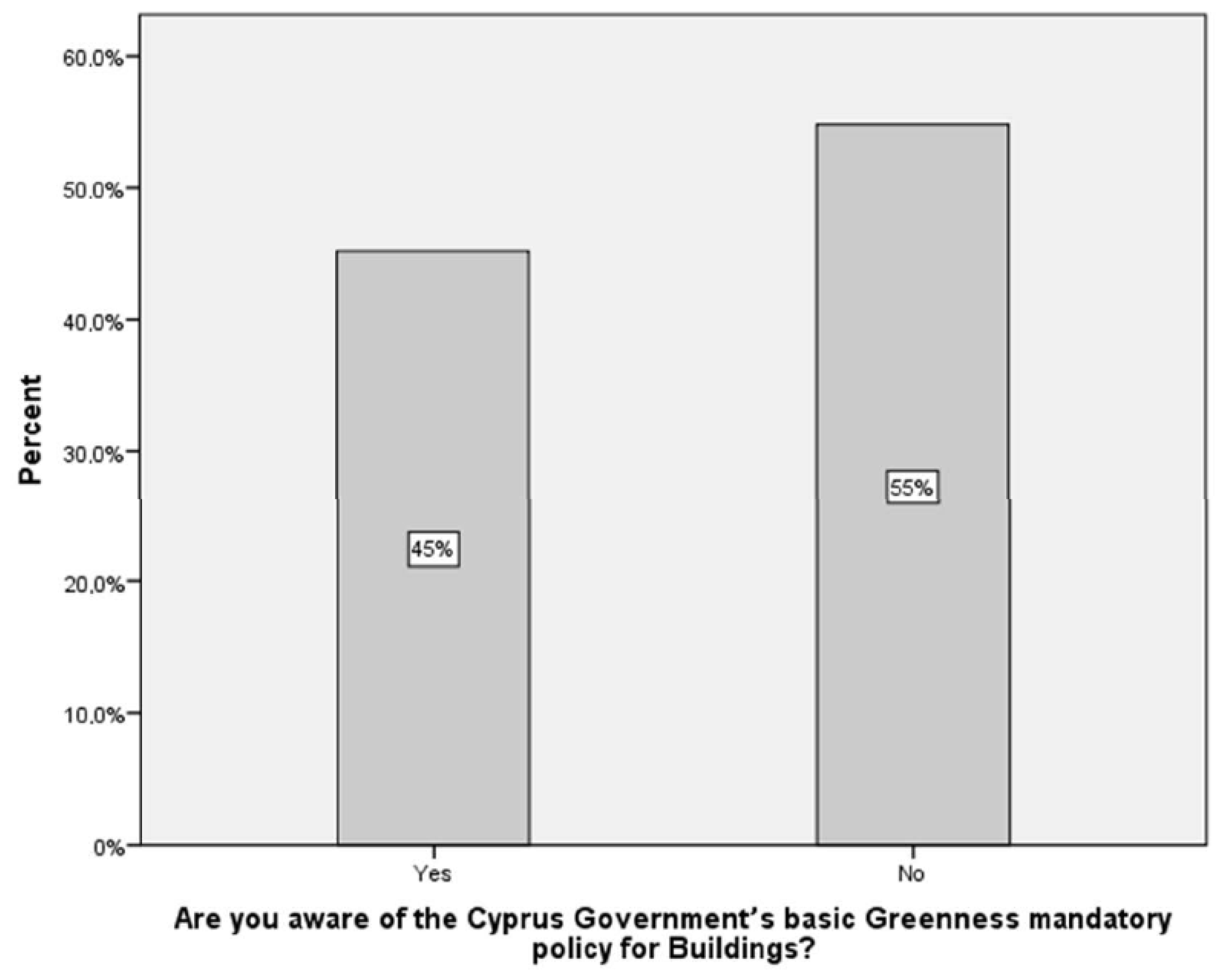
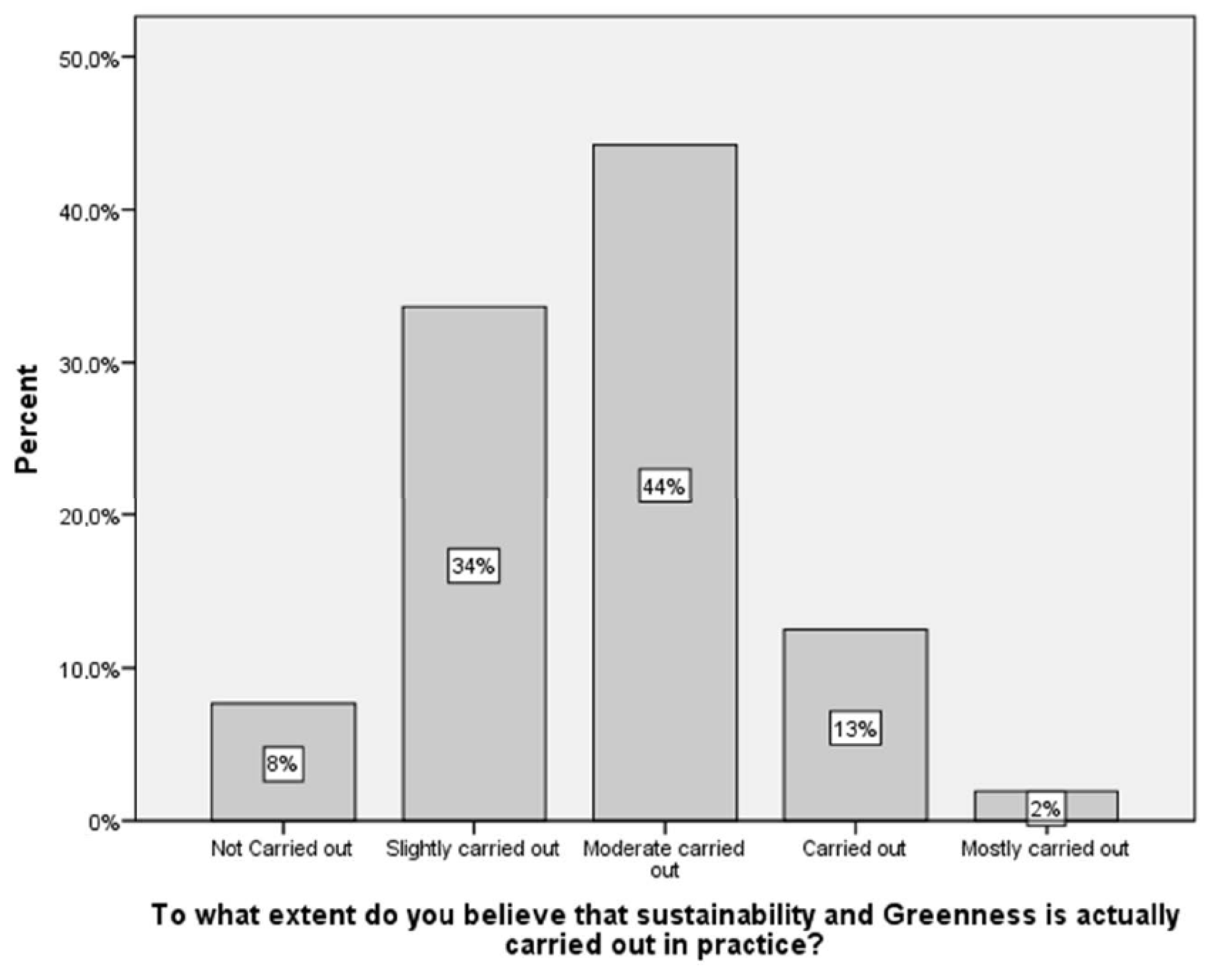

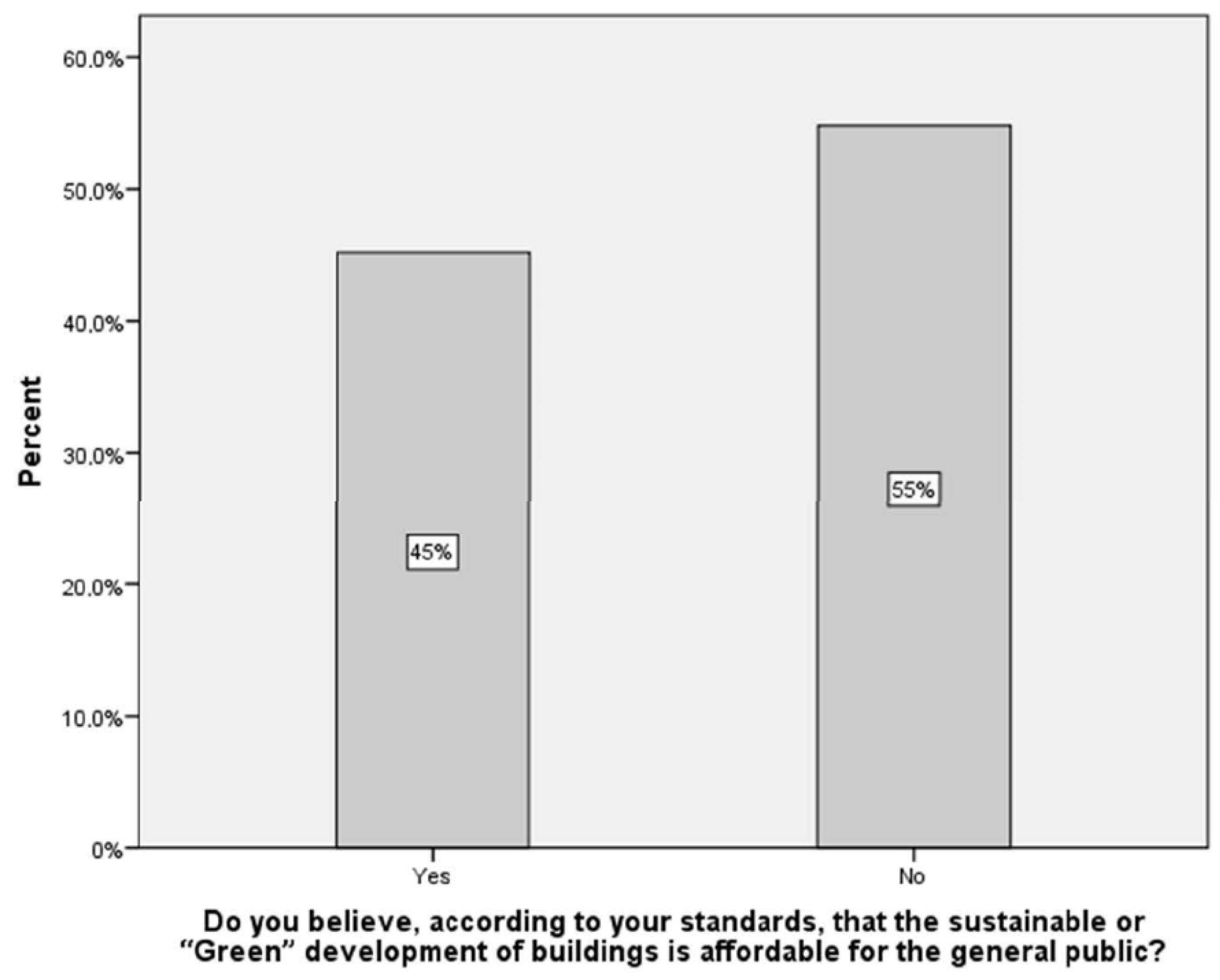

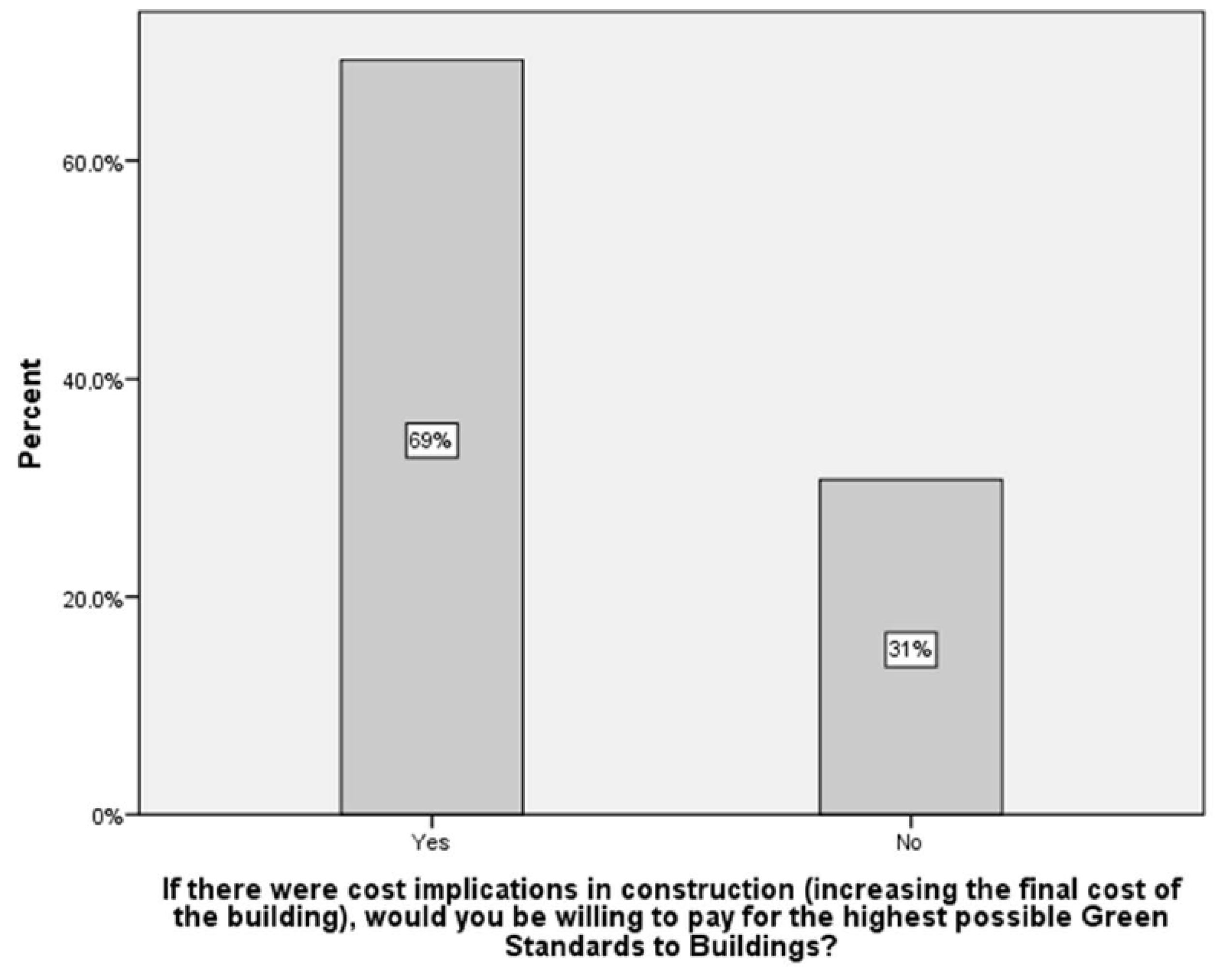
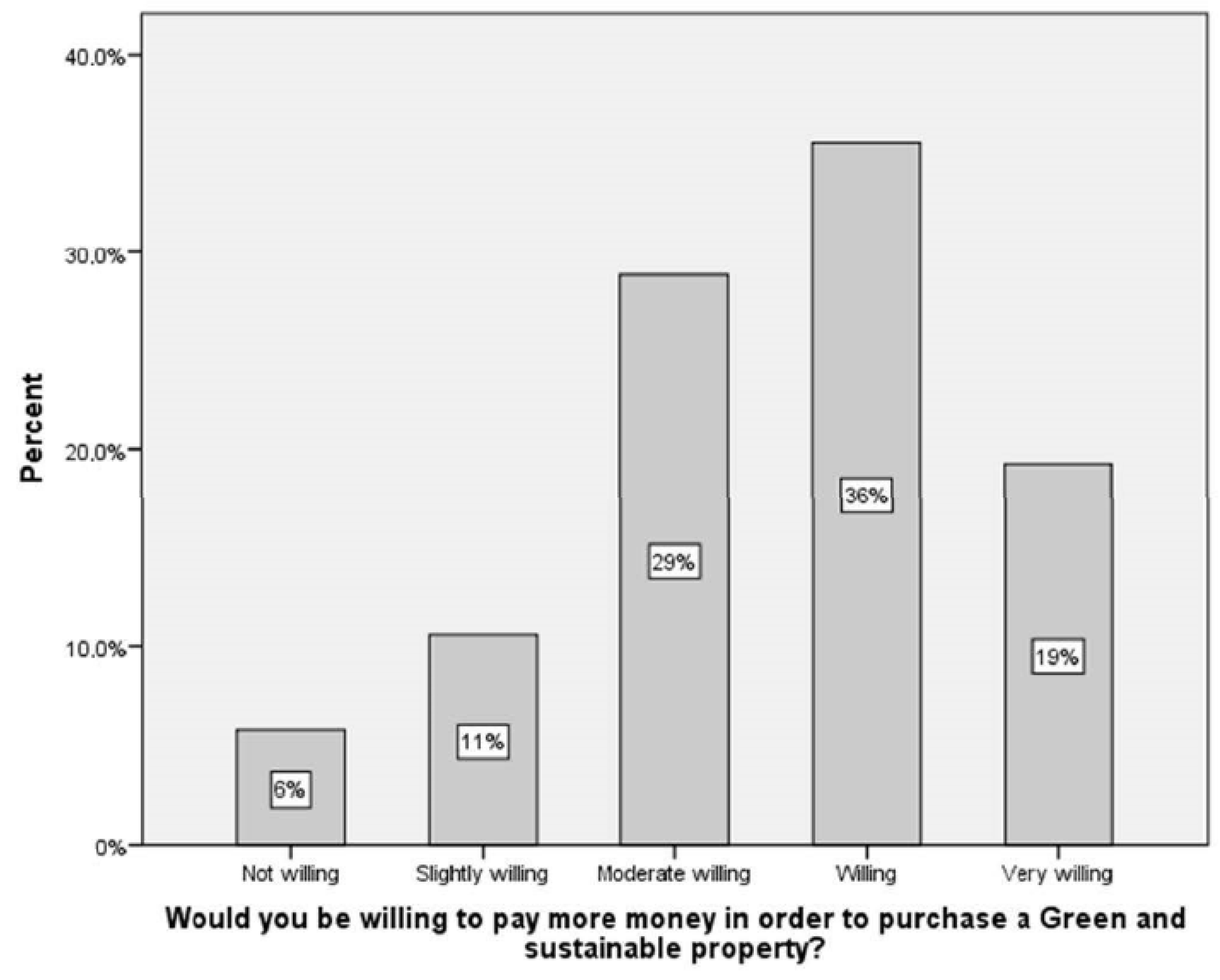

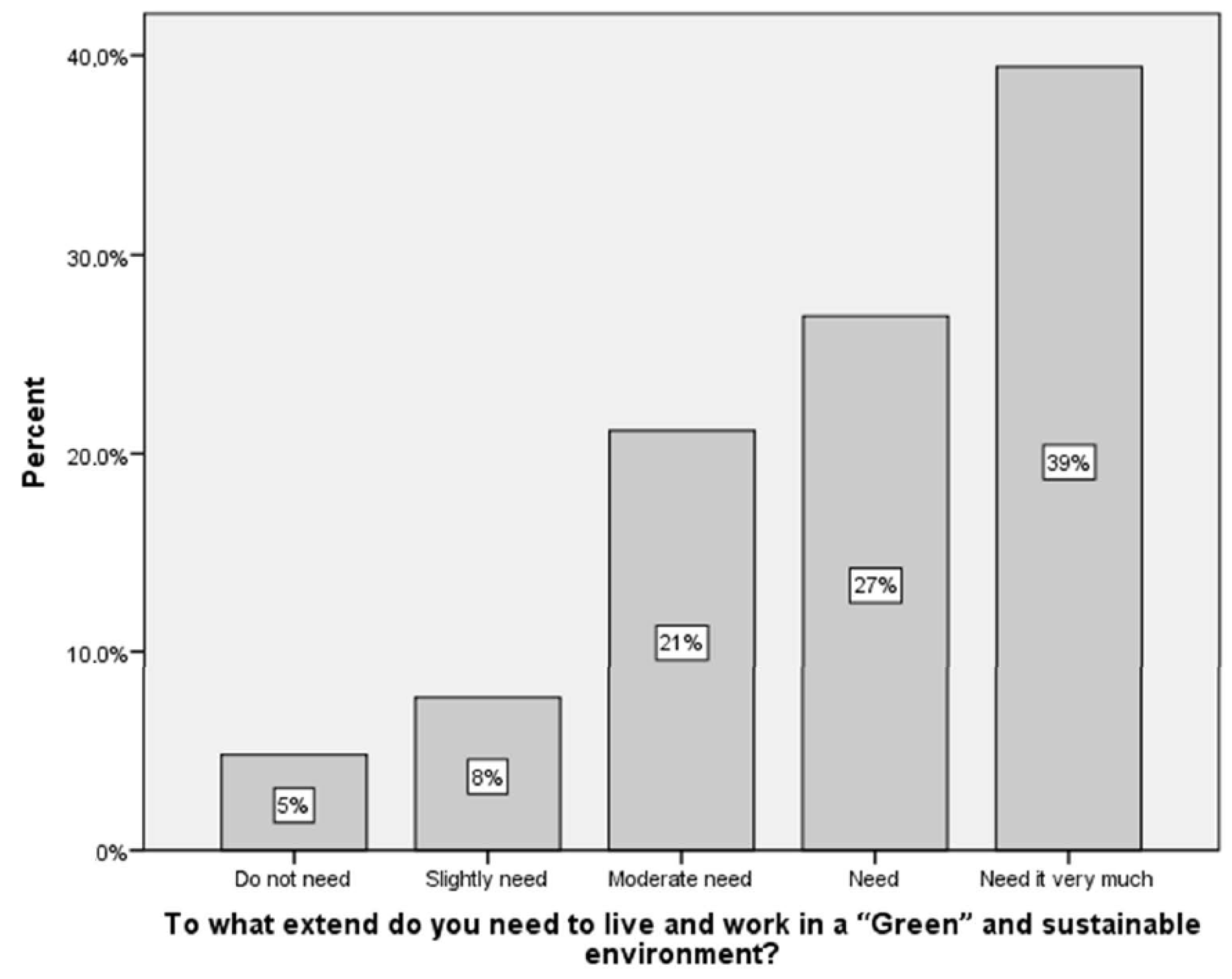
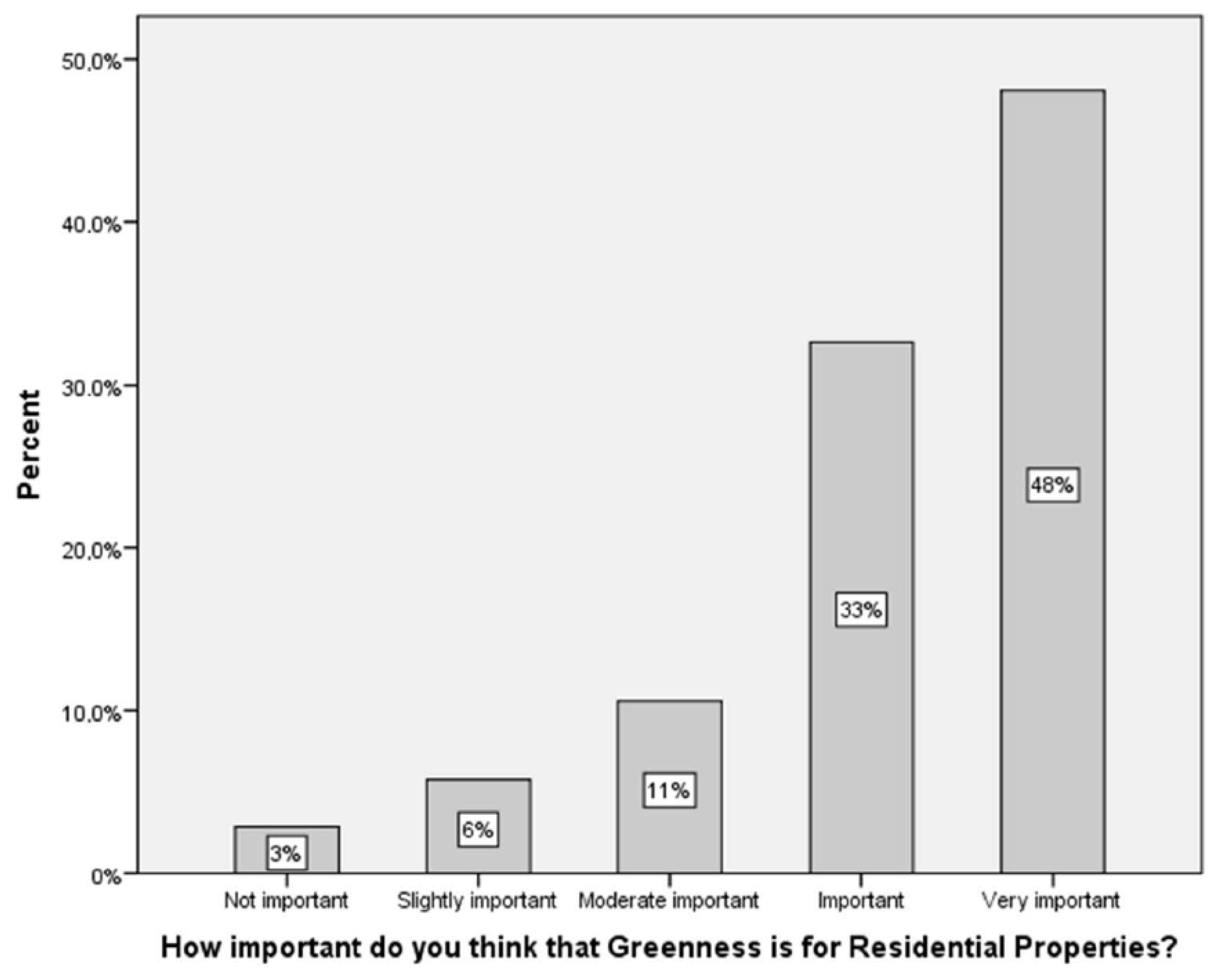
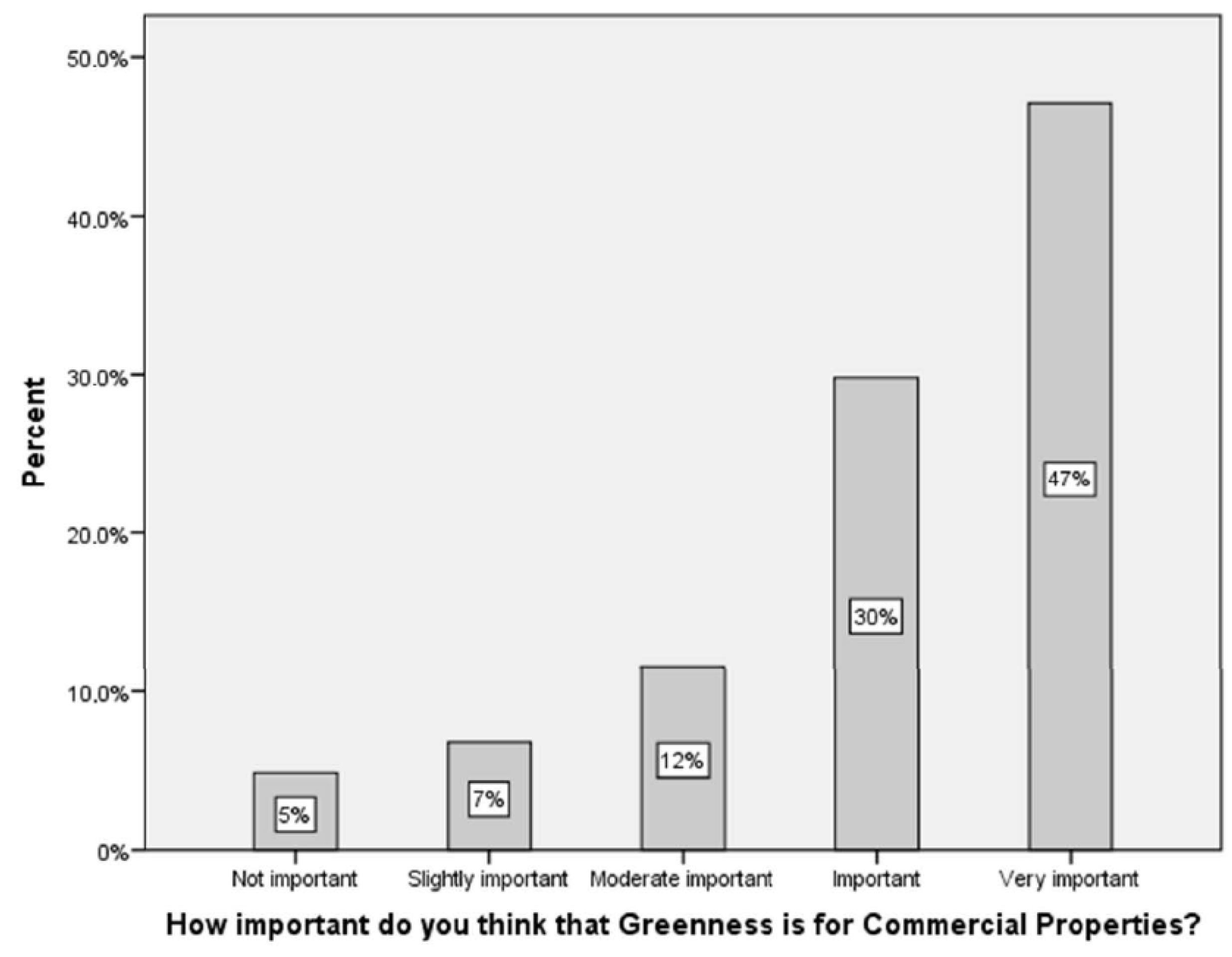
| Age | Frequency | Percent (%) |
|---|---|---|
| 20–30 | 14 | 13.5 |
| 30–40 | 28 | 27 |
| 40–60 | 50 | 48 |
| 60 or over | 12 | 11.5 |
| Gender | ||
| Male | 67 | 64 |
| Female | 32 | 31 |
| Other | 5 | 5 |
| Education Level | ||
| High school or less | 18 | 17 |
| Bachelor’s Degree | 43 | 41 |
| Master’s Degree | 38 | 36 |
| Doctorate | 5 | 5 |
| Occupation | ||
| Architect and Designer | 9 | 9 |
| Engineer | 16 | 15 |
| Estate Agent | 12 | 11 |
| Property Valuer | 5 | 5 |
| Property Developer | 6 | 6 |
| End-User (owner, tenant, and/or potential property buyer | 23 | 22 |
| Owner | 12 | 12 |
| Other | 21 | 20 |
| Household annual income | ||
| Below 20,000 EUR | 14 | 14 |
| 21,000–30,000 EUR | 20 | 19 |
| 31,000–40,000 EUR | 26 | 25 |
| 41,000–50,000 EUR | 19 | 18 |
| 51,000–60,000 EUR | 7 | 7 |
| Over 60,000 EUR | 18 | 17 |
| DV | IV |
|---|---|
| (A) Theme 2—Cost Implications (Including Q. 6–9) | Demographic Questions (Including Q. 1–5) Theme 1—Understanding and awareness of greenness/sustainability (including Q. 1–5) Theme 3—Greenness desirability and need (including Q. 10–12) |
| (B) Theme 3–Greenness desirability and need—Q.10 To what extent do you desire to live and work in a green and sustainable environment? | Demographic Questions (Including Q. 1–5) |
| (C) Theme 4—Residential versus commercial—Q. 13 How important do you think greenness is for residential properties? | Demographic Questions (Including Q. 1–5) Theme 1—Understanding and awareness of greenness/sustainability (including Q. 1–5) Theme 3—Greenness desirability and need (including Q. 10–12) |
| (D) Theme 4—Residential versus commercial—Q. 14 How important do you think greenness is for commercial properties? | Demographic Questions (Including Q. 1–5) Theme 1—Understanding and awareness of greenness/sustainability (including Q. 1–5) Theme 3–Greenness desirability and need (including Q. 10–12) |
| Model | R | R Square | Adjusted R Square | Std. Error of the Estimate |
|---|---|---|---|---|
| 1 | 0.753 | 0.567 | 0.505 | 0.29483 |
| Model | Sum of Squares | df | Mean Square | F | Sig. | |
|---|---|---|---|---|---|---|
| 1 | Regression | 10.261 | 13 | 0.789 | 9.081 | 0.000 b |
| Residual | 7.823 | 90 | 0.087 | |||
| Total | 18.084 | 103 |
| Unstandardized Coefficients | Standardized Coefficients Beta | t | Sig. | |||
|---|---|---|---|---|---|---|
| Model | B | Std. Error | ||||
| 1 | (Constant) | 2.943 | 0.409 | 7.191 | 0.000 | |
| What is your age? | −0.055 | 0.041 | −0.114 | −1.366 | 0.175 | |
| What is your gender? | −0.048 | 0.057 | −0.067 | −0.837 | 0.405 | |
| What is your education level? | −0.085 | 0.040 | −0.163 | −2.111 | 0.038 | |
| What is your occupation? | 0.047 | 0.015 | 0.270 | 3.123 | 0.002 | |
| What is your household annual income? | −0.046 | 0.023 | −0.178 | −1.962 | 0.053 | |
| Do you understand the meaning of “Greenness” in regards to the Building Sustainability and Efficiency? | −0.204 | 0.123 | −0.151 | −1.663 | 0.100 | |
| Do you believe that you have a clear understanding of the levels of Greenness in the Cyprus Real Estate Market? | 0.046 | 0.036 | 0.138 | 1.281 | 0.204 | |
| Are you aware of the Cyprus Government’s basic Greenness mandatory policy for Buildings? | −0.273 | 0.080 | −0.326 | −3.415 | 0.001 | |
| To what extent do you believe that sustainability and Greenness is actually carried out in practice? | −0.033 | 0.043 | −0.069 | −0.787 | 0.434 | |
| Do you believe that a property that has been following the sustainability and “Greenness” standards could be more privileged | −0.077 | 0.101 | −0.061 | −0.759 | 0.450 | |
| To what extent do you desire to live and work in a “Green” and sustainable environment? | 0.276 | 0.050 | 0.745 | 5.502 | 0.000 | |
| To what extent do you need to live and work in a “Green” and sustainable environment? | −0.086 | 0.052 | −0.238 | −1.663 | 0.100 | |
| Which of the following do you believe is the most important factor that influences the application of sustainability and Greenness in practice? | −0.008 | 0.023 | −0.027 | −0.366 | 0.715 | |
| Model | R | R Square | Adjusted R Square | Std. Error of the Estimate |
|---|---|---|---|---|
| 1 | 0.333 a | 0.111 | 0.065 | 1.09420 |
| Model | Sum of Squares | df | Mean Square | F | Sig. | |
|---|---|---|---|---|---|---|
| 1 | Regression | 14.629 | 5 | 2.926 | 2.444 | 0.039 b |
| Residual | 117.333 | 98 | 1.197 | |||
| Total | 131.962 | 103 |
| Unstandardized Coefficients | Standardized Coefficients Beta | t | Sig. | |||
|---|---|---|---|---|---|---|
| Model B | Std. Error | |||||
| 1 | (Constant) | 2.891 | 0.722 | 4.003 | 0.000 | |
| What is your age? | 0.072 | 0.145 | 0.055 | 0.500 | 0.618 | |
| What is your gender? | 0.223 | 0.206 | 0.115 | 1.083 | 0.281 | |
| What is your education level? | 0.220 | 0.140 | 0.157 | 1.568 | 0.120 | |
| What is your occupation? | −0.080 | 0.047 | −0.172 | −1.723 | 0.088 | |
| What is your household annual income? | 0.156 | 0.076 | 0.223 | 2.056 | 0.042 | |
| Model | R | R Square | Adjusted R Square | Std. Error of the Estimate |
|---|---|---|---|---|
| 1 | 0.856 a | 0.732 | 0.694 | 0.56908 |
| Model | Sum of Squares | df | Mean Square | F | Sig. | |
|---|---|---|---|---|---|---|
| 1 | Regression | 79.738 | 13 | 6.134 | 18.939 | 0.000 b |
| Residual | 29.147 | 90 | 0.324 | |||
| Total | 108.885 | 103 |
| Unstandardized Coefficients | Standardized Coefficients Beta | t | Sig. | |||
|---|---|---|---|---|---|---|
| Model | B | Std. Error | ||||
| 1 | (Constant) | 4.426 | 0.790 | 5.603 | 0.000 | |
| What is your age? | −0.089 | 0.078 | −0.075 | −1.137 | 0.258 | |
| What is your gender? | −0.078 | 0.110 | −0.044 | −0.706 | 0.482 | |
| What is your education level? | −0.207 | 0.077 | −0.163 | −2.677 | 0.009 | |
| What is your occupation? | −0.010 | 0.029 | −0.024 | −0.360 | 0.720 | |
| What is your household annual income? | −0.052 | 0.045 | −0.082 | −1.142 | 0.257 | |
| Do you understand the meaning of “Greenness” in regards to the Building Sustainability and Efficiency? | −0.739 | 0.237 | −0.222 | −3.118 | 0.002 | |
| Do you believe that you have a clear understanding of the levels of Greenness in the Cyprus Real Estate Market? | 0.075 | 0.070 | 0.091 | 1.071 | 0.287 | |
| Are you aware of the Cyprus Government’s basic Greenness mandatory policy for Buildings? | −0.260 | 0.154 | −0.126 | −1.685 | 0.095 | |
| To what extent do you believe that sustainability and Greenness is actually carried out in practice? | −0.045 | 0.082 | −0.038 | −0.546 | 0.586 | |
| Do you believe that a property that has been following the sustainability and “Greenness” standards could be more privileged | −0.449 | 0.195 | −0.145 | −2.311 | 0.023 | |
| To what extent do you desire to live and work in a “Green” and sustainable environment? | 0.578 | 0.097 | 0.637 | 5.976 | 0.000 | |
| To what extent do you need to live and work in a “Green” and sustainable environment? | −0.069 | 0.100 | −0.078 | −0.694 | 0.490 | |
| Which of the following do you believe is the most important factor that influences the application of sustainability and Greenness in practice? | 0.132 | 0.044 | 0.174 | 2.996 | 0.004 | |
| Model | R | R Square | Adjusted R Square | Std. Error of the Estimate |
|---|---|---|---|---|
| 1 | 0.808 a | 0.652 | 0.602 | 0.71795 |
| Model | Sum of Squares | df | Mean Square | F | Sig. | |
|---|---|---|---|---|---|---|
| 1 | Regression | 86.994 | 13 | 6.692 | 12.983 | 0.000 b |
| Residual | 46.390 | 90 | 0.515 | |||
| Total | 133.385 | 103 |
| Unstandardized Coefficients | Standardized Coefficients Beta | t | Sig. | |||
|---|---|---|---|---|---|---|
| Model | B | Std. Error | ||||
| 1 | (Constant) | 4.545 | 0.996 | 4.561 | 0.000 | |
| What is your age? | −0.272 | 0.099 | −0.207 | −2.754 | 0.007 | |
| What is your gender? | −0.073 | 0.139 | −0.037 | −0.522 | 0.603 | |
| What is your education level? | −0.240 | 0.098 | −0.171 | −2.460 | 0.016 | |
| What is your occupation? | 0.038 | 0.037 | 0.080 | 1.037 | 0.302 | |
| What is your household annual income? | 0.048 | 0.057 | 0.068 | 0.837 | 0.405 | |
| Do you understand the meaning of “Greenness” in regards to the Building Sustainability and Efficiency? | −1.088 | 0.299 | −0.295 | −3.635 | 0.000 | |
| Do you believe that you have a clear understanding of the levels of Greenness in the Cyprus Real Estate Market? | 0.037 | 0.088 | 0.040 | 0.418 | 0.677 | |
| Are you aware of the Cyprus Government’s basic Greenness mandatory policy for Buildings? | −0.368 | 0.195 | −0.162 | −1.890 | 0.062 | |
| To what extent do you believe that sustainability and Greenness is actually carried out in practice? | −0.052 | 0.104 | −0.040 | −0.505 | 0.615 | |
| Do you believe that a property that has been following the sustainability and “Greenness” standards could be more privileged | −0.103 | 0.245 | −0.030 | −0.421 | 0.675 | |
| To what extent do you desire to live and work in a “Green” and sustainable environment? | 0.583 | 0.122 | 0.580 | 4.777 | 0.000 | |
| To what extent do you need to live and work in a “Green” and sustainable environment? | −0.047 | 0.126 | −0.048 | −0.376 | 0.707 | |
| Which of the following do you believe is the most important factor that influences the application of sustainability and Greenness in practice? | 0.112 | 0.056 | 0.133 | 2.008 | 0.048 | |
Disclaimer/Publisher’s Note: The statements, opinions and data contained in all publications are solely those of the individual author(s) and contributor(s) and not of MDPI and/or the editor(s). MDPI and/or the editor(s) disclaim responsibility for any injury to people or property resulting from any ideas, methods, instructions or products referred to in the content. |
© 2023 by the authors. Licensee MDPI, Basel, Switzerland. This article is an open access article distributed under the terms and conditions of the Creative Commons Attribution (CC BY) license (https://creativecommons.org/licenses/by/4.0/).
Share and Cite
Katafygiotou, M.; Protopapas, P.; Dimopoulos, T. How Sustainable Design and Awareness May Affect the Real Estate Market. Sustainability 2023, 15, 16425. https://doi.org/10.3390/su152316425
Katafygiotou M, Protopapas P, Dimopoulos T. How Sustainable Design and Awareness May Affect the Real Estate Market. Sustainability. 2023; 15(23):16425. https://doi.org/10.3390/su152316425
Chicago/Turabian StyleKatafygiotou, Martha, Pavlos Protopapas, and Thomas Dimopoulos. 2023. "How Sustainable Design and Awareness May Affect the Real Estate Market" Sustainability 15, no. 23: 16425. https://doi.org/10.3390/su152316425
APA StyleKatafygiotou, M., Protopapas, P., & Dimopoulos, T. (2023). How Sustainable Design and Awareness May Affect the Real Estate Market. Sustainability, 15(23), 16425. https://doi.org/10.3390/su152316425








